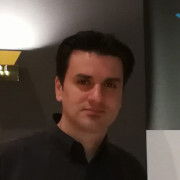Visceral Manipulation: Manual Thermal Evaluation and VisceroEmotional Relationships (VM5)
VM5 studies the use of Manual Thermal Evaluation to evaluate and improve organ functions.
- Date:24-07-2025 09:00 AM - 27-07-2025 06:00 PM
- Location: Barral Institute Hong Kong / Upledger Institute Hong Kong
Online Registration
Description
Instructor: Nabil Lahlouh Gonzalez, PT, DO, BI-D

Visceral Manipulation: Manual Thermal Evaluation and VisceroEmotional Relationships (VM5)
VM5 is divided into 2 parts: Manual Thermal Evaluation and Visceral Emotional Listening
Manual Thermal Evaluation – This is an evaluation method developed by Jean-Pierre Barral, DO, MRO(F) that utilizes sensitivity to temperature changes to identify dysfunction within the body. It is useful across a wide spectrum of health disciplines and augments other forms of evaluation.
Barral developed this "topographical map" of the physical structures that we have been learning in the previous levels. He developed this "map" with the assistance of engineers and a physicist who helped him design an instrument (thermal scanner) that measures "heat" coming off the body - infrared heat that is the same temperature as dysfunctional tissues within the body. This was the measuring tool to validate Barral's hands for this "off the body" scanning - another evaluation tool for physical and emotional dysfunctions. This map shows where both physical and emotional dysfunctions are held in the body.
Visceral Emotional Listening - A basic tenet of Barral Visceral Manipulation is that the body is able to heal itself unless accumulated stress is too great. We accept that:
- Musculoskeletal structure is involved in many diseases
- Emotions contribute to physical problems / many diseases.
- Emotions can be stored in the body.
- Emotions are our emotional anatomy.
- Emotions affect visceral dysfunction.
However, there are few systems to palpate, evaluate and treat emotions. Emotions should dissipate - flow through you - not become an overwhelming amount of stored energy! Tissues become stressed if emotion stays in an organ or when the same organ is stressed over and over. Jean-Pierre Barral found that if a large amount of energy is tied up in the process of storing emotion, there is less energy available to adapt to current situations. Jean-Pierre also finds that patients often suffer because depending on who is treating them, they are often told either "It is all in your head" or "Your problem is purely structural". The VM5 course is as much about finding emotional connections as it is about discovering that a physical problem might well be just that.
In VM5 we review each of the body cavities and revisit some of the techniques learned in VM1-VM4, as we learn new evaluative tools for listening to the "messages of the body." The techniques learned are essential to the whole person evaluation and treatment. Each organ holds emotions; it is our "stop gap system" for the mind. Primarily the organs and the plexi hold emotions, and when discharged, the body/mind communication can be restored.
Within the curriculum we focus on the organs and their relationships to the neuromusculoskeletal structures. We realize we are "waking up a little something in this process", as Barral often states. Now we are deepening the understanding of that often-times-illusive link between body and mind. Barral's techniques for working with the emotions of the body are as specific as his techniques for working with physical structures. We do not guess where emotions are stored; we feel them with our hands. We help the body "discharge" those areas of restrictions that are decompensating the system.
We discuss how movement is the key to life. Now we realize that without emotions there is no real living of life. It is normal to have emotions; it is life. Where we run into problems is when these emotions are not discharged. Our history is our biology.
This class allows the practitioner to go deeper into the evaluation of dysfunctions of the body and the integration of body/mind in a "tissue listening" way. The tools learned in this class are as specific as those learned in the previous levels of the visceral work. This work is unique with its "nonverbal dialoguing" and mechanical ways of linking body to mind.
Course Highlights
- Discover the scientific understanding of body heat, and the clinical significance of changes in surface temperature.
- Learn the use of Manual Thermal Evaluation to find restrictions and organ dysfunction in the body.
- Review VM1-VM4 while learning topography of the organs and their manual thermal palpation.
- Explore the synchronicity between the body and brain, and how that affects the health of a person.
- Discover how the brain uses the internal organs to discharge and express excess energy (often of emotional origin) and how that affects structural integrity.
- Learn specificity of working with structure and the emotions.
- Help the body discharge stored emotional energy with precision
- Practice working with energy loss, locating structural restrictions contributing to pain, and managing a therapeutic session.
- Evaluate if emotion is 0%, 1% or 100% of the problem.
Prerequisite
VM3 and VM4
